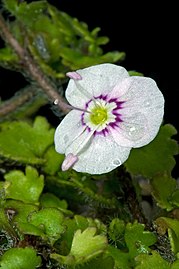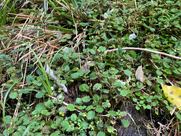
Veronica sect. Hebe is a group of plants within the genus Veronica, native to New Zealand, Rapa in French Polynesia, the Falkland Islands and South America. It was formerly treated as the separate genus Hebe. It includes about 90 species. Almost all species occur in New Zealand, apart from Veronica rapensis and Veronica salicifolia, found in South America. It is named after the Greek goddess of youth, Hebe. Informally, species in the section may be called shrubby veronicas or hebes.

Solanum aviculare, commonly called poroporo or pōporo, bumurra (Dharug), kangaroo apple, pam plum (Australia), or New Zealand nightshade, is a soft-wooded shrub native to New Zealand and the east coast of Australia.

Veronica is the largest genus in the flowering plant family Plantaginaceae, with about 500 species. It was formerly classified in the family Scrophulariaceae. Common names include speedwell, bird's eye, and gypsyweed.

Kunzea ericoides, commonly known as kānuka, kanuka, or white tea-tree, is a tree or shrub in the myrtle family, Myrtaceae and is endemic to New Zealand. It has white or pink flowers similar to those of Leptospermum and from its first formal description in 1832 until 1983 was known as Leptospermum ericoides. The flowers have five petals and up to 25 stamens which are mostly longer than the petals.
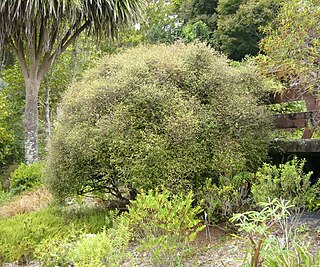
Muehlenbeckia astonii or shrubby tororaro is an endemic New Zealand shrub in the family Polygonaceae. It has distinctive small heart-shaped deciduous leaves amidst a tangle of wiry interlocking branches. Although common in cultivation around the world, it is extremely rare and threatened in the wild.

Hibbertia scandens, sometimes known by the common names snake vine, climbing guinea flower and golden guinea vine, is a species of flowering plant in the family Dilleniaceae and is endemic to eastern Australia. It is climber or scrambler with lance-shaped or egg-shaped leaves with the narrower end towards the base, and yellow flowers with more than thirty stamens arranged around between three and seven glabrous carpels.

Pennantia baylisiana, commonly known as Three Kings kaikōmako or kaikōmako manawatāwhi (Māori), is a species of plant in the family Pennantiaceae. It is endemic to Manawatāwhi / Three Kings Islands, around 55 kilometres (34 mi) northwest of Cape Reinga, New Zealand. At the time of its discovery just one plant remained. This single tree grows on a scree slope inaccessible to browsing goats, and has been called "the world's loneliest tree". The species was discovered in 1945 by botanist Geoff Baylis and described in 1948, although it took decades before it was it was fully accepted as a distinct species of Pennantia. Although the only wild tree is female, it was successfully propagated from cuttings in the 1950s, one of which was induced to self-pollinate in 1985. Subsequent seed-grown plants have themselves set seeds, and the species has been replanted on the island, the adjoining mainland, and in public and private gardens around New Zealand.

Veronica odora, known as the boxwood hebe, mountain-box, Hebe odora or Hebe buxifolia, is a plant in the family Plantaginaceae, and it is native to New Zealand. Veronica odora was discovered on the Auckland Islands by J.D Hooker in 1840. A certain amount of confusion later arose following its collection on mainland New Zealand by Ernst Dieffenbach and its naming as Veronica buxifolia by George Bentham. Even overseas, Veronica odora is still not infrequently known as Veronica buxifolia.

Veronica perfoliata, commonly known as digger's speedwell, is a common perennial herb found at higher altitudes in south-eastern Australia. It is a low-growing multi-stemmed plant rising from a woody rootstock. It has rounded blue-grey foliage and sprays of intense violet-blue flowers at the end of arching branches. It is occasionally cultivated as a garden plant.
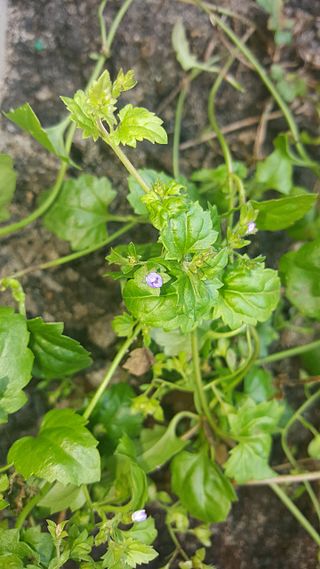
Veronica plebeia, commonly known as creeping- or trailing speedwell, is a species of flowering plant belonging to the family Plantaginaceae. It is native to Australia and New Zealand.

Veronica strictissima, the Banks Peninsula hebe, is a species of flowering plant in the family Plantaginaceae. It is only found on Banks Peninsula in New Zealand.

Ranunculus viridis, the Mount Allen buttercup, is a critically endangered species of alpine Ranunculus (buttercup), endemic to Rakiura/Stewart Island, New Zealand, where it occurs at altitudes of 700 metres (2,300 ft) on Mount Allen in the Tin Range.

Dracophyllum arboreum, commonly known as Chatham Island grass tree and tarahinau (Moriori), is a species of tree in the heath family Ericaceae. Endemic to the Chatham Islands of New Zealand, it reaches a height of 18 m (60 ft) and has leaves that differ between the juvenile and adult forms.

Plantago aucklandica is a species of flowering plant in the family Plantaginaceae that is endemic to the subantarctic Auckland Islands, New Zealand. Joseph Dalton Hooker described P. aucklandica in his Flora Antarctica in 1844. Plants of this plantain are large with large leaves, up to seven veins, wide petioles, colliculate seeds, and long spikes with dozens of flowers and one-seeded fruits. This species in considered to be At Risk - Naturally Uncommon, as it is an island endemic with a restricted range.

Plantago triantha is a species of flowering plant in the family Plantaginaceae that is native to Tasmania, Australia and the subantarctic Auckland Islands of New Zealand. Robert Brown described the species in 1810. Plants of this species of plantain are annual or perennial with a rosette habit, fleshy toothed leaves, and short inflorescences.

Jovellana repens is an endemic New Zealand plant in the family Calceolariaceae spread through both the North and South Islands. It has small green leaves and white flowers with spots of purple on the inside.
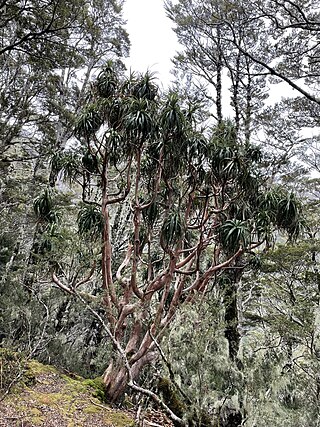
Dracophyllum traversii, commonly known as mountain neinei, grass tree, and pineapple tree is a species of flowering plant in the heath family Ericaceae. It is a deciduous tree endemic to New Zealand. It reaches a height of 0.2–13 m (0.66–42.65 ft) and has leaves which form tufts at the end of its branches. It has a lifespan of between 500 and 600 years.

Dracophyllum ophioliticum, commonly known as asbestos inaka and asbestos turpentine tree, is a species of shrub in the family Ericaceae. Endemic to New Zealand, it grows into a sprawling shrub, reaching heights of just 30–200 cm (10–80 in), and has leaves which form bunches at the end of its branches.
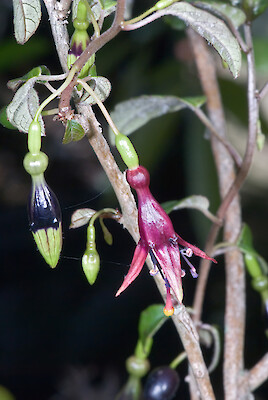
Fuchsia perscandens, commonly known as climbing fuchsia or scrambling fuchsia, is a species of plant endemic to New Zealand and belonging to the family Onagraceae. Fuchsia perscandens belongs to the South Pacific Skinnera section, which consists of three species and a hybrid.
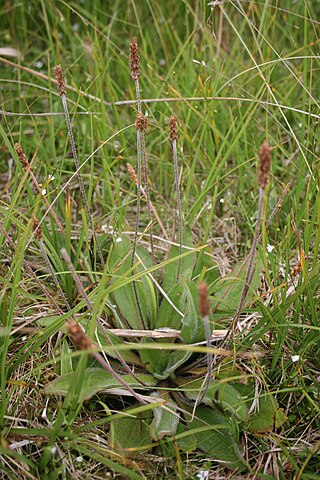
Plantago udicola is a species of flowering plant in the family Plantaginaceae that is endemic to New Zealand. Heidi Meudt and Philip Garnock-Jones described P. udicola in 2012. Plants of this species of plantain are perennial with a rosette habit, leaves widest above the middle, seeds uniform, ellipsoid and 1–4 per capsule, edges of bracts sparsely hairy, edges of sepals with isolated hairs at the apex only, and a chromosome number of 2n = 96 (dodecaploid). It is listed as Not Threatened.



